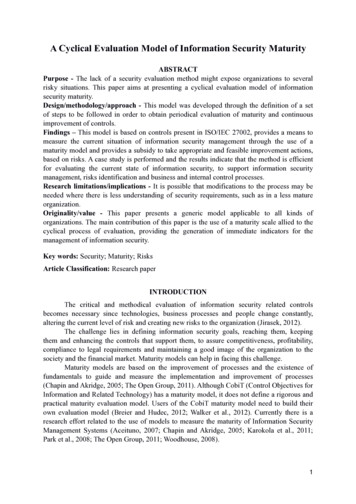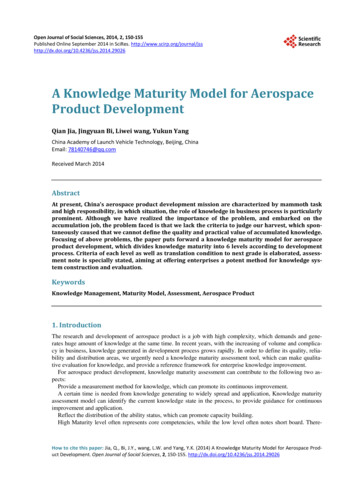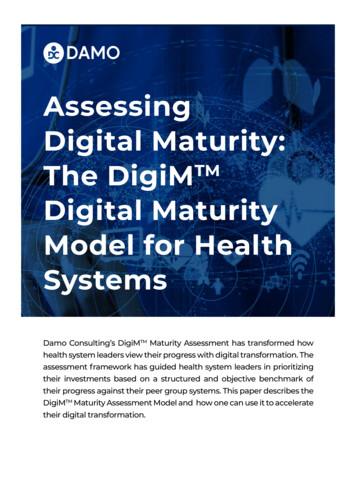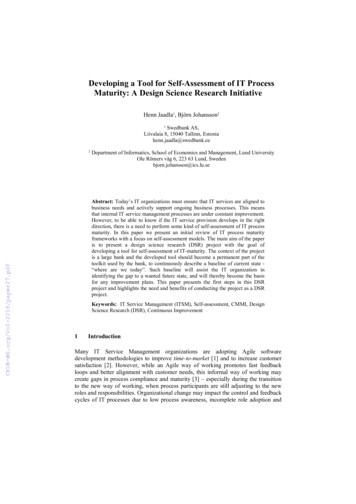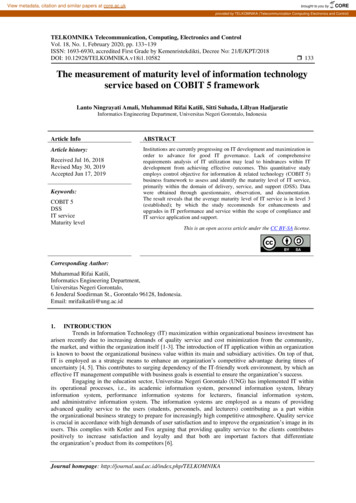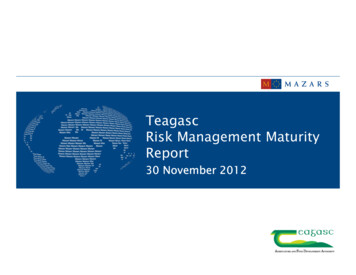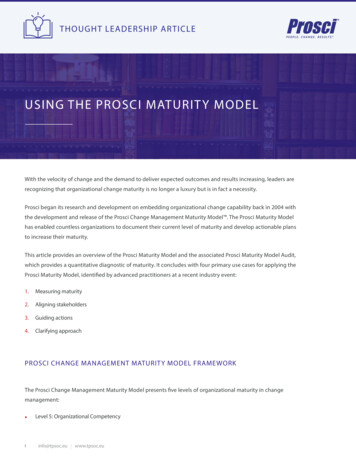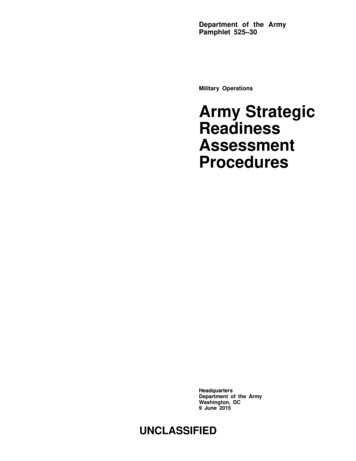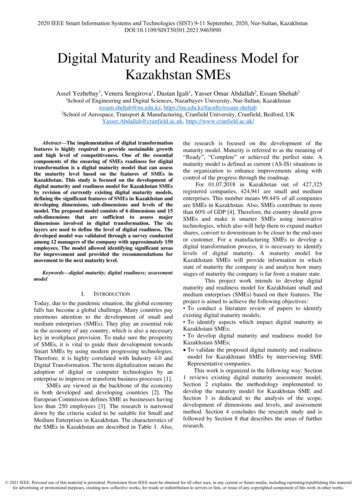
Transcription
2020 IEEE Smart Information Systems and Technologies (SIST) 9-11 September, 2020, Nur-Sultan, l Maturity and Readiness Model forKazakhstan SMEsAssel Yezhebay1, Venera Sengirova1, Dastan Igali1, Yasser Omar Abdallah2, Essam Shehab11School of Engineering and Digital Sciences, Nazarbayev University, Nur-Sultan, Kazakhstanessam.shehab@nu.edu.kz, https://nu.edu.kz/faculty/essam-shehab2School of Aerospace, Transport & Manufacturing, Cranfield University, Cranfield, Bedford, UKYasser.Abdallah@cranfield.ac.uk, https://www.cranfield.ac.uk/Abstract—The implementation of digital transformationfeatures is highly required to provide sustainable growthand high level of competitiveness. One of the essentialcomponents of the ensuring of SMEs readiness for digitaltransformation is a digital maturity model that can assessthe maturity level based on the features of SMEs inKazakhstan. This study is focused on the development ofdigital maturity and readiness model for Kazakhstan SMEsby revision of currently existing digital maturity models,defining the significant features of SMEs in Kazakhstan anddeveloping dimensions, sub-dimensions and levels of themodel. The proposed model consists of 6 dimensions and 15sub-dimensions that are sufficient to assess majordimensions involved in digital transformation. The sixlayers are used to define the level of digital readiness. Thedeveloped model was validated through a survey conductedamong 12 managers of the company with approximately 150employees. The model allowed identifying significant areasfor improvement and provided the recommendations formovement to the next maturity level.Keywords—digital maturity; digital readiness; assessmentmodelI.INTRODUCTIONToday, due to the pandemic situation, the global economyfalls has become a global challenge. Many countries payenormous attention to the development of small andmedium enterprises (SMEs). They play an essential rolein the economy of any country, which is also a necessarykey in workplace provision. To make sure the prosperityof SMEs, it is vital to guide their development towardsSmart SMEs by using modern progressing technologies.Therefore, it is highly correlated with Industry 4.0 andDigital Transformation. The term digitalization means theadoption of digital or computer technologies by anenterprise to improve or transform business processes [1].SMEs are viewed as the backbone of the economyin both developed and developing countries [2]. TheEuropean Commission defines SME as businesses havingless than 250 employees [3]. The research is narroweddown by the criteria scaled to be suitable for Small andMedium Enterprises in Kazakhstan. The characteristics ofthe SMEs in Kazakhstan are described in Table 1. Also,the research is focused on the development of thematurity model. Maturity is referred to as the meaning of“Ready”, “Complete” or achieved the perfect state. Amaturity model is defined as current (AS-IS) situations inthe organization to enhance improvements along withcontrol of the progress through the roadmap.For 01.07.2018 in Kazakhstan out of 427,325registered companies, 424,941 are small and mediumenterprises. This number means 99.44% of all companiesare SMEs in Kazakhstan. Also, SMEs contribute to morethan 60% of GDP [4]. Therefore, the country should growSMEs and make it smarter SMEs using innovativetechnologies, which also will help them to expand marketshares, convert to downstream to be closer to the end-useror customer. For a manufacturing SMEs to develop adigital transformation process, it is necessary to identifylevels of digital maturity. A maturity model forKazakhstani SMEs will provide information in whichstate of maturity the company is and analyze how manystages of maturity the company is far from a mature state.This project work intends to develop digitalmaturity and readiness model for Kazakhstani small andmedium enterprises (SMEs) based on their features. Theproject is aimed to achieve the following objectives: To conduct a literature review of papers to identifyexisting digital maturity models; To identify aspects which impact digital maturity inKazakhstani SMEs; To develop digital maturity and readiness model forKazakhstani SMEs; To validate the proposed digital maturity and readinessmodel for Kazakhstani SMEs by interviewing SMERepresentative companies.This work is organized in the following way: Section1 reviews existing digital maturity assessment model,Section 2 explains the methodology implemented todevelop the maturity model for Kazakhstan SME andSection 3 is dedicated to the analysis of the scope,development of dimensions and levels, and assessmentmethod. Section 4 concludes the research study and isfollowed by Section 8 that describes the areas of furtherresearch. 2021 IEEE. Personal use of this material is permitted. Permission from IEEE must be obtained for all other uses, in any current or future media, including reprinting/republishing this materialfor advertising or promotional purposes, creating new collective works, for resale or redistribution to servers or lists, or reuse of any copyrighted component of this work in other works.
II.LITERATURE REVIEWThe systematic literature review conducted on theresearch question. Existing maturity and readiness modelsidentified and analyzed in 16 research articles. Out of 16articles, seven are chosen for further analysis according tothe relevance to the small and medium enterprises,number of dimensions, measurement scale, features,country of research origin and limitationsA. Maturity model of digitalization for SMEThe maturity model to measure the level ofdigitization in SMEs. The model identifies the mainaspects which impact the digital maturity of theorganization and proposes three levels of maturity fromLevel 1to Level 3 in order to evaluate six dimensionsdescribed in the following paragraphs.There are six dimensions to assess to identify itsdigital maturity level with identified weights for eachdimension. They are strategy and leadership, companyculture and organization, IT infrastructure, data maturity,process and operations, and product [5].The maturity level is identified by using of 5-pointLikert scale ranges between “Totally disagree to Totallyagree” for each dimension described above. The result foreach dimension could be calculated by finding thearithmetic mean of all provided ratings for the samedimension.B. Connected Enterprise Maturity modelThe Connected Enterprise Maturity model wasproposed by Rockwell automation in 2014. The focus ofthe model is on manufacturing companies with the lowestlevel of maturity to the mature stage holders, whichfrequently correspond to the small and mediumenterprises at different stages of enterprise lifecycle.According to the model, it is essential to concentrateattention to the collaboration across the enterprise bylinking processes, people and facilities using Informationtechnologies. The article is not focused precisely onSME. However, still applicable since explanations of thestages refer to the companies at formation and growthstages, which lead to the assumption of applicability fromSMEs. According to the article, the enterprise is in amature stage when it is a connected enterprise. There arefive stages defined in the article: assessment, secure andupgraded network and controls, defined and organizedworking data capital, analytics and collaborations.In the assessment stage, the model assesses thenetwork between operations technology and informationtechnology using four dimensions: hardware andsoftware, controls and devices, network that move allinformation and security policies [6].C. IMPULS maturity modelThe IMPULS “Industry 4.0 Readiness” model wasdeveloped by IMPULS Foundation of the GermanEngineering Federation. It was primarily dedicated to theAssessment of manufacturing and mechanicalengineering companies. The model consists of sixdimensions: employees, strategy and organization, smartfactory, smart operations, data driven services and smartproducts.The six dimensions are applied for thedevelopment of a six-level model (from 0 to 5) each ofwhich contains the minimum requirements for movementto the next level. In this system, Level 0 is the companiesunprepared for implementation of digitalization activities,and Level 5 are top performers that show all features ofdigital maturity.Hamidi et al. (2018) applied the IMPULS modelfor Assessment of the Malaysian SMEs viaquestionnaires that were distributed via email to morethan 250 companies from various industries [7]. Therepresentatives of companies weighted the score ofdimensions by themselves, and the average result wastaken for further Assessment. The study showed thatoverall, the SMEs in Malaysia has a lack of knowledgerequired for digitalization primarily in the field of datadriven services, strategy and smart factory.D. Towards a Maturity Model for Industry 4.0The maturity model aims to help companies to applytechnologies related to Industry 4.0 and as result guide toenhancing capabilities. Therefore, model concentrates oncapabilities of the company in a standardized andrepetitive manner and helps to draw a roadmap to reach amore mature state.It describes 2D relation between capability andaspect dimensions. Capability dimension, as describedabove, refers to the capabilities of the company. Itincludes following levels from level zero to level six intotal “incomplete, performed, managed, established,predictable, optimizing”. Aspect dimension includessubdimensions such as “asset management, ormation, organizational alignment”.E. Smart Manufacturing Maturity Model for SMEs(SM3E)The SM3E maturity model is a three-axis modelthat consists of five critical organizational dimensions (xaxis) related to the manufacturing operations, modulartoolkit (y-axis) including seven toolboxes, and fivematurity levels (z-axis).In this SM3E maturity model, the fiveorganizational dimensions, including finance, people,strategy, process, and product, were selected from theSME perspective. The toolkit is a collection of techniquesand practices that lead to the desired goal. The modulartoolkit of the model considers the following seventoolboxes: (1) manufacturing toolbox; (2) design andsimulation toolbox; (3) robotics and automation toolbox;(4) sensors and connectivity toolbox; (5) cloud/storagetoolbox; (6) data analytics toolbox; (7) businessmanagement toolbox. The five basic maturity levels for
SMEs were considered in this model that include: Novice,Beginner, Learner, Intermediate, and Expert [2].F. The System Integration Maturity Model Industry 4.0(SIMMI 4.0)The SIMMI 4.0 is aimed to determine thereadiness of the SMEs for Industry 4.0 in terms of the ITsystem landscape. This maturity model assesses the ITperformance of the enterprise in terms of fourdimensions, including vertical integration, horizontalintegration, digital product development, and crosssectional technology criteria. Overall, the five maturitystages were considered in this model, including basicdigitization level (stage 1), cross-departmentaldigitization (stage 2), horizontal and vertical digitization(stage 3), full digitization (stage 4), optimized fulldigitization (stage 5). There are formulae to compute thematurity stage of each dimension based on thequestionnaire. The overall maturity level is found bycalculating the arithmetic mean of the maturity levels ofall dimensions. This maturity model has been applied tosix companies coming from the manufacturing, systemengineering/consulting, service provider/tax consultant,and commerce sectors [8].G. The Three-Stage Maturity Model in SMEs towardsIndustry 4.0The Three-Stage Maturity Model is aimed toimprove the diversification capabilities of the SMEtowards Industry 4.0. The SMEs can diversify in severalways; however, this model considers the diversificationthat involves the participation of the same company inseveral business sectors.The Three-Stage Maturity Model is composed ofthree stages, including envision, enable, enact whichguide and train SMEs for diversification opportunities.The maturity scale for each stage is defined with the fivelevels: initial (level 1), managed (level 2), defined (level3), transform (level 4), and detailed BM (BusinessModel) (level 5) [9].H. Industry 4.0 Maturity ModelThe maturity model includes the following ninedimensions: “strategy, leadership, customers, products,operations, culture, people, governance and technology”.Each dimension corresponds to the implementation ofIndustry 4.0 concepts by checking the resources, thewillingness of management and leaders, interaction withcustomers, collection and utilization of data, use oftechnologies, knowledge sharing and more. Listeddimensions divided further into 62 subdimensions andafter Assessment of maturity level model corresponds toone of the available in the model 1-5 levels of maturity.Level 5 is considered as the highest level of digitalmaturity in the company and shows conformance withconcepts of Industry 4.0. The model utilizes a Likertscale measurement scale after the performance of thesurveys.III.METHODOLOGYAs a tool that can be used as a guide for thetransformation process, maturity model has the followingtypical characteristics: Dimensions are specific capability areas that arefurther specified using subareas; Levels are states of maturity in a particulardimension and have a distinguishing descriptor; Principles of maturity are divided intocontinuous (scoring at different levels) and staged(specify goals to reach a certain level); Assessment approach can be either qualitativewith the use of descriptions or quantitative (with Likertscale, e.g.).The basic Maturity model development processproposed by Lahmann (2010) is used in this study [10]. Itwas adapted to fulfil the purposes of the research. Thefinal version consists of the following stages:1. Scope. This phase aims to identify the audienceon which the model will focus. At this stage, the featuresand desires of stakeholders must be specified todetermine model requirements.2. Design. The design phase determines theconcept of maturity, the structure of the level system,dimensions and sub-dimensions if any with completedescriptions. In the study, a bottom-up approach is usedthat means that MM firstly specify dimensions andmaturity characteristics and only then derive a descriptionof the corresponding maturity levels.3. Populate. This stage defines the Assessmenttools of the MM and specifies the applied instruments.IV.MODEL DEVELOPMENTA. ScopeThe implementation of Industry 4.0 features is anindispensable component of economic and market modelsimprovement, as it is stated in “Development StrategyKazakhstan 2050” [11]. In 2017, Ministry forInvestments and Development depicted the followingfeatures of the Kazakhstani industrial enterprises:approximately 80% of enterprises in the manufacturingsector (mechanical engineering, metallurgy, etc.) are atthe level of Industry 2.0 that is semiautomatedmanufacturing, while the percentage of companiesshowing the features of Industry 3.0 is 3%. The rest of thecompanies is at the transitional level. The Assessmentwas made based on the level of technologies, strategy andmanagement, production and organization, personnel andcommunication [12].The main identified challenges and barriers are alack of qualified specialists, financial support,telecommunication infrastructure development, low levelof local competences and limited understanding ofnecessity lying behind digital transformation. However,this study was focused on large enterprises such as
Eurasian Foods JSC, Kentau Transformer Plant JSC, etc.So, there is evidence for lack of attention towardsdigitalization of SMEs in the Republic of Kazakhstan.According to the results of 2019, SMEs with theoverall number of 1.186 million contributed 28% to GDPof Kazakhstan. This number gradually increasesthroughout that last five years. Based on “Kazakhstan2050” strategy, the GDP share of SMEs should compose50% to provide the stability of economic growth [13]. So,the main driving force for digital transformation inKazakhstan is the government that offers reliable supportfor further development. According to Rakhimova, in2018, a training program for entrepreneurs was launchedto increase digital literacy, and over 15 thousandentrepreneurs have trained annually [14].The SWOT analysis presented in Table 3 wasperformed to assess the state of SMEs in Kazakhstan.Overall, it can be said that SMEs have a high potential forfuture growth and technological improvement in case ifsupport from government is appropriately performed anda qualification level of employees is increased. Moreover,it is necessary to pay more attention to the developmentof strategy, culture and operational effectiveness.Table 1. SWOT analysis for Kazakhstan SMEs.StrengthsThe necessity for small-scaleseed capital;Ability to provide quickresponse to changes in marketconditions;Possibility for rapid changes instructure, strategy, culture ifimprovements are needed;Comparatively low amount ofinvestment and short paybackperiodOpportunitiesLow barriersfor marketpenetration;Strong support measures fromthe governmentDevelopment of new products;High capital turnover;Further expansionWeaknessesLack of active cooperation withlarge enterprises;Low qualification level ofentrepreneursProblems of access to financialsources;No clearly stated developmentstrategy or cultureShort life cycle;ThreatsHigh competition level betweendomesticandforeigncompanies;High probability for low returnon investment for digitalization;Limited market;Vulnerability to the economiccrisis;.To sum up, the primary audience of this study isSMEs that needs to determine the level of readiness fordigitalization, taking into account the basic low level ofpeople and technology readiness. Moreover, it mustconsider that the primary focus for any SME is itscustomers and quality of its products, as even a slightdecrease in customer satisfaction may fail the companybecause of a low amount of budget. The primary focus ison manufacturing and engineering companies in allindustries.B. DesignBased on the current state of SMEs in Kazakhstan,the following requirements can be stated for the digitalmaturity assessment model: the digital literacy level of both managers andemployees; skills and qualification of company leaders; course towards digitalization said in companystrategy and budget; level of technologies used; digitalization level of process and operations; the level of digitalization for the process of gettingfeedback on the product from customers, to trackthe satisfaction level of customers;The dimensions and sub-dimensions of the modelwere developed based on the requirements of KazakhstanSMEs. It has six dimensions and 15 sub-dimensionsshown in Figure 1: People. The changes that the digital workplace maybring mostly affect employees working in thecompany, so it is necessary to check if they canadapt to alterations in the working environment,acquire new qualifications and skills. The readinessin this dimension is determined by the analysis oftheir skills in various areas and efforts of thecompany to acquire a new set of skills. Moreover, itis necessary to assess the knowledge sharing cultureand cross-company collaboration. Leadership. Innovation management that is acrucial part of any transformation is measured inthis case in addition to the personal integrity ofleaders. Strategy. Digitalization is not only the mean toimprove the products or processes, but also theopportunity of new business models development.In this dimension, strategy and investments areassessed. Technology. The dimension of technology evaluatesthe existence of modern ICT, utilization of machineto-machine communication Operations. As a result of the digitalization ofcompany operations, it is possible to reachoperational excellence with the enhancement ofefficiency through greater automation, decrease thecost of product and thus customize them. It isnecessary to measure supply chain management,information sharing and automation of processes. Product. This dimension is primarily concerned onthe equipment of products with ICT componentssuch as a sensor to collect data on their environmentand communicate with higher-level systems toimprove processes of production and guide themautonomously. The ICT add functionalities and dataanalytics in the usage phase (to gather feedbackfrom customers) are assessed in this dimension. Italso accounts for individualization of products.
FunctionalitiesIndividu based on ationAnalytics for rategyFigure 1. Model dimensions and sub-dimensions.The model is divided into six maturity levels that assessthe current readiness of the company. Each level has itsdescription (shown in Figure 2) and requirements formovement to the next level. Zero level stands foroutsiders who have not implemented any digitalizationpractices yet. The second level is the beginner who hadsome attempts for digital transformation; Level 2 isintermediate phase companies who have theinfrastructure of operating smart technologies. Next levelstands for experienced companies with verticalintegration and network of manufacturing systems. Level4 is for experts with horizontal integration through valuenetwork who already implemented big data analytics andmachine learning. Moreover, finally, Level 5 is the topperformers who performed the features of digital maturityand has continuous adaptation and self-optimization.Figure 2. Model levelsC. PopulateThe phase of the population is designed to consist ofthree steps: the aim of the first is to measuresubdimensions with the use of a questionnaire, after thisthe maturity level is calculated and then representedvisually with the provision of some furtherrecommendations. It is necessary to mention that theemployees of the companies are suggested to have basicknowledge of what is digital transformation and of itsmain features. Otherwise, it is highly advisable to conductworkshops for the provision of required knowledge.The questionnaire with 16 questions is developedin order to measure the readiness of a company based on16 sub-dimensions. The example of one of the questionsthat should be delivered to companies. The first part of thequestionnaire is dedicated to the Assessment ofdimensions. Each question has six types of answers thatare: not exist, launched, in development, formulated, inimplementation and implemented.The next step is Assessment of weighting factorfrom not too important to very important. The scale from1 to 4 is chosen to avoid the neutral answer that is oftengiven in case if there is a middle answer. With this part ofthe questionnaire, the company has an opportunity toassess the importance of every factor for digitaltransformation by itself, as it is suggested to differsignificantly from company to company and fromindustry to industry.The next step of the population phase is thecalculation of the maturity level. It is calculated theformula shown in Equation 1, where M stands formaturity, D- for dimensions, I-for item or subdimension,g is a weighting factor, and n is the number of maturityitems. The equation is adapted from the study conductedby Schumacher et al. (2016).(1)The last phase is the Assessment of the companyreadiness for digital transformation and visualrepresentations of the results. The team made the trialassessment for the industry company with the number ofemployees approximately 150 people. The team checkedand validated it on the company employees. Themanagers of departments were asked to answer questions,and 12 answers were gathered. They had some issues andrecommendations, and the model was improved based onthem. The total score of each dimension is shown inTable 2. The results are also visualized with the aid of aradar chart in Figure 3 from level 0 to level 3. It can beseen that this company vitally needs to improve the areasof product and technology, while people, leadership andoperations are at a comparatively high level. The overallmaturity level can be assessed as Level 2 means that thecompany succeed in the installation of smart technologyinfrastructure that still operates independently from oneanother. The company needs to work towards thedevelopment of vertical integration and a system ofnetworked manufacturing.
Table 2. The assessment results of the nalytics in usage phaseIndividualization1,201,342,300,00ICT basedfunctionalitiesSkill acquisitions0,923,201,504,00Skill set1,404,002,302,303,5Innovation managementPersonal 3,400,71ICT functionsAutomationInformation sharingSCMREFERENCES[1]Cross pment Competitive Research Grant Program(FCDRGP) Grant No. 110119FD4524.The authors would like to express their gratitude tothe participants of the assessment model for spendingtheir time and providing valuable feedback andinformation.2,08[2][3]2,70[4][5][6][7][8]Figure 3. The radar chart for the digital maturity of the companyV.CONCLUSIONIn this paper, the digital maturity and readinessmodel for Kazakhstan SMEs was proposed based on theanalysis of existing digital maturity assessment modelsand the current state of SMEs in Kazakhstan. The mainrequirements for the digital maturity model wereidentified; the model was developed and validatedthrough an interview with a company. The trial maturityassessment was conducted, and the results were obtainedand visualized. The model has proven itself as applicablefor Kazakhstan SMEs and allowed the provision ofrecommendations for further actions to achieve the nextlevel of digital maturity.There are still numerous areas for improvement ofthe model. It is necessary to assess the role of governmentin the digitalization of SMEs, as it is extremely valuablefor developing countries. The model should be furtherrefined, and the guideline for adopting by KazakhstanSMEs should be e authors would like to thank NazarbayevUniversity for funding this article under the Faculty[15]M. Rachinger, R. Rauter, C. Müller, W. Vorraber, and E. Schirgi,“Digitalization and its influence on business model innovation,”Journal of Manufacturing Technology Management, vol. 30, no. 8,pp. 1143–1160, Sep. 2019.S. Mittal, M. A. Khan, D. Romero, and T. Wuest, “A criticalreview of smart manufacturing & Industry 4.0 maturity models:Implications for small and medium-sized enterprises (SMEs),”Journal of Manufacturing Systems, vol. 49, pp. 194–214, 2018.N. Oregan and A. Ghobadian, “Re-visiting the strategyperformance question: an empirical analysis,” InternationalJournal of Management and Decision Making, vol. 5, no. 2/3, p.144, 2004.“Annual report on SME Kazakhstan,” atameken.kz, s/docs/reminders/2019-04/otchet-2kvartal-2018 1555049568.pdf.F. Blatz, R. Bulander, and M. Dietel, “Maturity Model ofDigitization for SMEs,” 2018 IEEE International Conference onEngineering, Technology and Innovation (ICE/ITMC), 2018.“The Connected Enterprise,” RockwellAutomation.com. wp002 -en-p.pdf. [Accessed: 13-Jun-2020].S. R. Hamidi, A. A. Aziz, S. M. Shuhidan, A. A. Aziz, and M.Mokhsin, “SMEs Maturity Model Assessment of IR4.0 DigitalTransformation,” Advances in Intelligent Systems and ComputingProceedings of the 7th International Conference on KanseiEngineering and Emotion Research 2018, pp. 721–732, 2018.C. Leyh, T. Schäffer, K. Bley, and S. Forstenhäusler, “Assessingthe IT and Software Landscapes of Industry 4.0-Enterprises: TheMaturity Model SIMMI 4.0,” Information Technology forManagement: New Ideas and Real Solutions Lecture Notes inBusiness Information Processing, pp. 103–119, 2017J. Ganzarain and N. Errasti, “Three stage maturity model inSME’s toward industry 4.0,” Journal of Industrial Engineering andManagement, vol. 9, no. 5, p. 1119, 2016.“Business Intelligence Maturity Models: An Overview,” D'Atri,Ferrara and Spagnoletti (eds.) Proceedings of the VII Conferenceof the Italian Chapter of AIS, Naples, Italy, 2010.“Digital Kazakhstan – official source of state program .”[Online]. Available: https://digitalkz.kz/en/. [Accessed: 13-Jun2020].Report Of The Minister Of Industry And InfrastructureDevelopment Of The Republic Of Kazakhstan at The InternationalForum "Digital Agenda In The Age Of Globalization” balizacii. [Accessed: 13-Jun-2020].Staff Report in Business on 21 November 2019, “Kazakhstan'sdigital transformation has a 578 million positive effect ,” nsformation-has-a-578-million-positive-effect/. [Accessed: 13Jun-2020].S. A. Rakhimova and M. M. Turgumbekova, “Programs OfGovernment Support For Sme In The Republic Of KazakhstanAnd Measures To Enhance Their Efficiency,” Series Of SocialAnd Human Sciences, vol. 6, no. 322, pp. 233–240, 2018.A. Schumacher, S. Erol, and W. Sihn, “A Maturity Model forAssessing Industry 4.0 Readiness and Maturity of ManufacturingEnterprises,” Procedia CIRP, vol. 52, pp. 161–166, 2016
E. Smart Manufacturing Maturity Model for SMEs (SM. 3. E) The SM. 3. E maturity model is a three-axis model that consists of five critical organizational dimensions (x-axis) related to the manufacturing operations, modular toolkit (y-axis) including seven toolboxes, and five maturity levels (z-axis). In this SM. 3. E maturity model, the five

